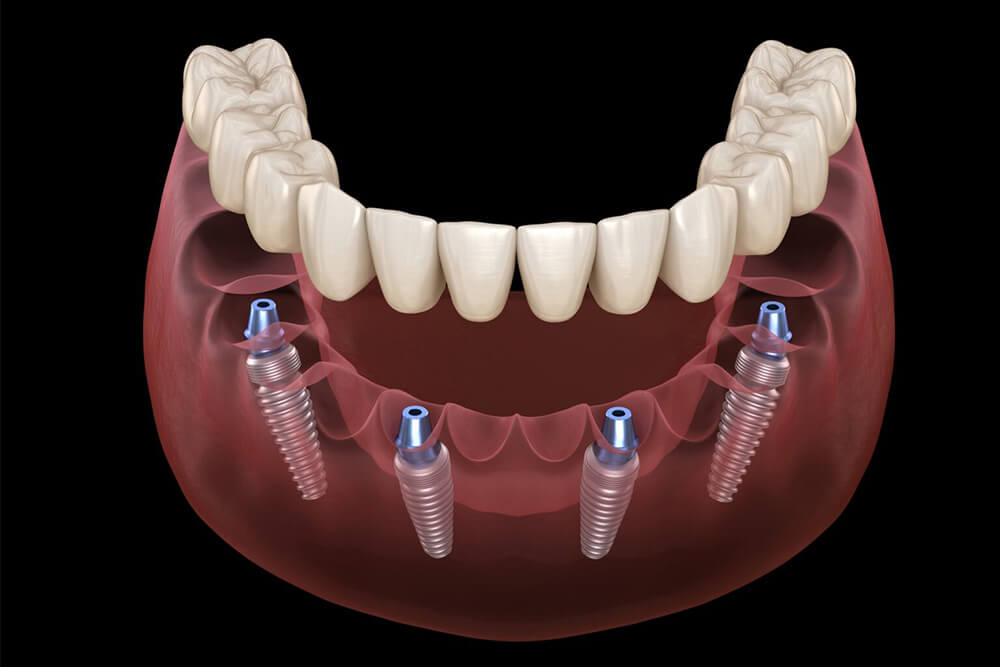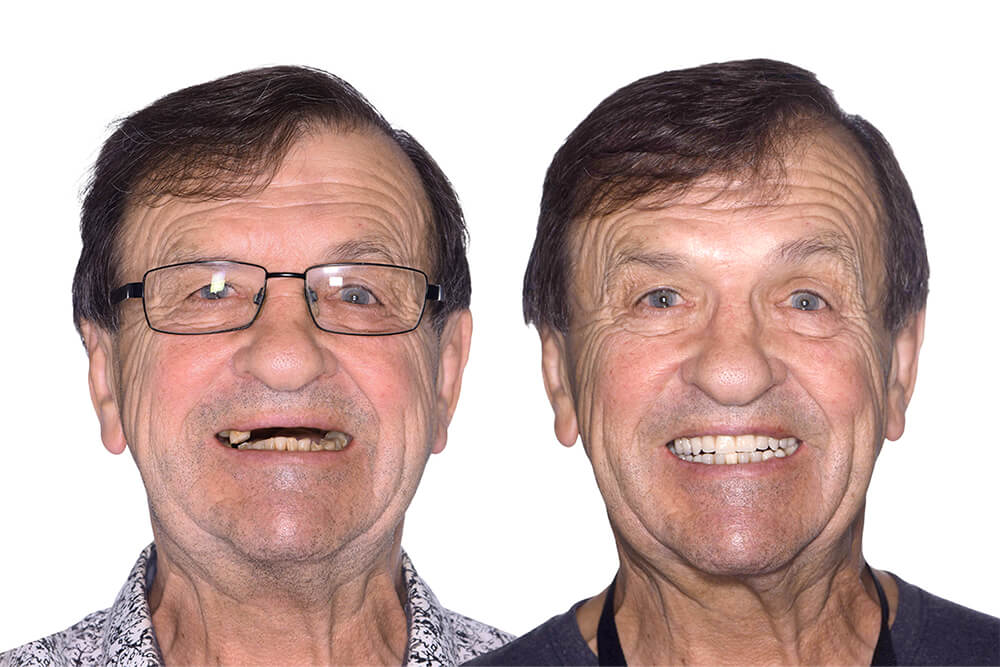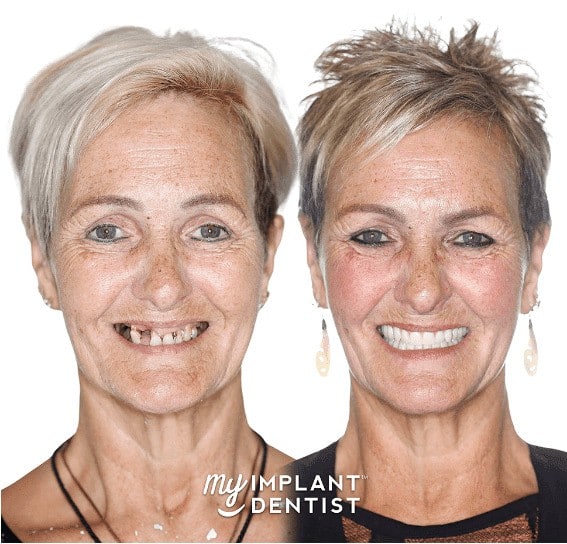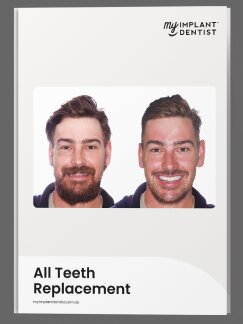It is possible to have a dental implant placed on the same day, when your tooth has been extracted.
In particular, All-on-4 dental implants can be placed on the same day. All on 4 implants replace all teeth on the upper or lower jaw. The “four” in the name stands for all teeth resting on four dental implants, that are screwed into your jaw bone. Because your teeth are resting on four implants, they are more stable than single tooth implants.
If you only need to replace a single tooth, your dentist will most likely tell you to wait 3-6 months for the surgical site to heal before placing the final crown on top of the implant.
During this time, osseointegration will take place (3-6 months after surgery).
The process of the dental implant fusing to your jaw bone is called osseointegration and takes around 3 to 6 months after the tooth implant has been surgically placed.
Once the site is healed, you can have your dental crown placed on top of the implant.
Our ‘can I get implants years later after tooth extraction’ article discusses the situation where patients have waited many years between tooth extraction and dental implant placement.

Contents
- 1 How long can I wait to get a dental implant after my tooth has been extracted?
- 2 Immediate Dental Implant Placement
- 3 Waiting for Your Mouth to Heal
- 4 Is There Anything I Can Do to Alleviate My Post-Implant Pain?
- 5 How Long Is The Wait For Dental Implants After Tooth Extraction?
- 6 Factors Affecting the Length of Time Between Tooth Extraction and Dental Implant Placement
- 7 Immediate Dental Implant Placement vs. Waiting for the Mouth to Heal
- 8 What Happens After Tooth Loss?
- 9 When is Bone Grafting Required?
- 10 faq
- 10.1 How long after pulling a tooth can you get an implant?
- 10.2 Can dental implants be placed immediately after extraction?
- 10.3 Is a dental implants more painful than a tooth extraction?
- 10.4 When is it too late to get dental implants?
- 10.5 Are dental implants necessary after extraction?
- 10.6 Can I go for a dental implant one year after extraction?
How long can I wait to get a dental implant after my tooth has been extracted?
The longer you wait for the tooth implant procedure, the more bone mass will be lost, making the implant less stable. After the extraction, you will need a follow-up visit to your dentist.
Your dentist will perform an X-ray and provide you with a personalised treatment plan, as well as a quote for the cost of dental implants.
Should you decide to go ahead, after the surgery, your mouth will need two to three weeks to heal, and a second appointment may be required to complete the procedure.
Depending on the bone mass in your jaw, the implant will need to be placed in the jawbone without the need for bone grafting.
Once the surgical implant site has healed, your dentist will place an abutment on the implant and attach a crown to it.
Read on to discover why extractions may be required in the beginning and the rest of the dental implant procedure.

Immediate Dental Implant Placement
Placing a dental implant immediately after the tooth has been extracted is the most common method. The benefit of immediate placement is that no jaw bone mass will be lost.
Waiting for Your Mouth to Heal
Dental implant placement is a surgical procedure, that requires three to six months of healing time before having a final crown.
In some cases, the dental implant can be placed earlier but should be done after the entire three-month healing period.
The duration of the dental procedure depends on your condition and your jawbone’s health.
If the jawbone is healthy, it is possible to have an implant on the same day. Several factors will determine whether you can have an implant on the same day.
Long before the actual surgical procedure, your dentist will tell you if you require bone grafting or a sinus lift.
Is There Anything I Can Do to Alleviate My Post-Implant Pain?
If you are considering dental implants in Perth, it is important to research and choose a reputable and experienced implant dentist.
After tooth implant surgery, you can take these steps to improve your mood and speed up the healing process:
- Take your prescribed medication as prescribed.
- To relieve pain, take acetaminophen and ibuprofen as prescribed.
- To relieve pain and swelling, apply ice to the area around your implant.
- Do not use a straw, spit, rinse, or smoke to loosen the blood clots and interfere with the recovery of the wounds.
- Rinse and brush your teeth with a mixture of warm saltwater and water.
- Twenty-four hours after surgery, begin brushing and rinsing, but avoid the surgical site.
- Avoid strenuous activity and heavy lifting immediately following surgery.
- Ensure that you get enough sleep.
How Long Is The Wait For Dental Implants After Tooth Extraction?
If you live in South Perth and have a tooth that needs to be extracted, you probably want it replaced as quickly as possible. After all, a missing tooth affects not only your smile’s appearance but also your ability to bite and chew. Having a tooth knocked out can be embarrassing and frustrating, as well.
Factors Affecting the Length of Time Between Tooth Extraction and Dental Implant Placement
There are several factors that can affect the length of time between tooth extraction and dental implant placement. One of the most important factors is the health of the jawbone. If the jawbone is strong and healthy, it may be possible to place the dental implant immediately after the tooth has been extracted. However, if the jawbone is weak or has been damaged, the implant may not be able to properly fuse to the bone, leading to instability and an increased risk of failure. In these cases, it may be necessary to wait several months or even years for the jawbone to heal and strengthen before proceeding with the implant placement.
Another factor that can affect the length of time between tooth extraction and dental implant placement is the need for bone grafting or sinus lifts. Bone grafting involves the addition of bone tissue to the jawbone to provide a strong and stable foundation for the implant. A sinus lift involves the elevation of the sinus floor to make room for the implant. Both of these procedures require additional healing time, which can extend the length of time between tooth extraction and implant placement.
Immediate Dental Implant Placement vs. Waiting for the Mouth to Heal
Immediate dental implant placement involves the insertion of the implant into the jawbone immediately after the tooth has been extracted. This can be a good option for patients who want to replace their extracted tooth as quickly as possible. However, there are some potential drawbacks to immediate implant placement. For example, the surgical site may not be fully healed, which can increase the risk of infection or other complications. In addition, the implant may not properly fuse to the jawbone if it is placed too soon after the tooth has been extracted.
On the other hand, waiting for the mouth to heal before placing the dental implant can help to reduce the risk of complications and increase the chances of long-term success. This typically involves a waiting period of three to six months after the tooth has been extracted, during which time the surgical site will fully heal and the jawbone will strengthen. After this period, the implant can be placed and allowed to fuse to the jawbone through the process of osseointegration.
What Happens After Tooth Loss?
Having a tooth extracted by a dentist can be uncomfortable, but it can also cause changes that you may not notice right away. Tooth loss causes jawbone deterioration because of a lack of stimulation from the tooth, which causes bone loss. As a bonus, the open space allows for the movement of the teeth around it to occur. As a result of this shift in alignment, your ability to eat properly may be affected and the development of jaw problems, such as TMJ.
When is Bone Grafting Required?
Your oral surgeon may need to transplant a small amount of bone from another site in the upper or lower jawbone to secure the Brisbane dental implant.
Bone grafting may be required if your jawbone is too thin or soft to support dental implants. To ensure that your bone is strong enough to support the implant, your mouth’s powerful chewing action exerts tremendous pressure on it. It is possible to strengthen the implant’s foundation with a bone graft.
faq
How long after pulling a tooth can you get an implant?
You can get an implant anywhere from 3 to 9 months after pulling a tooth. The length of time you have to wait depends on the type of implant you choose and whether or not you need a bone graft.
Can dental implants be placed immediately after extraction?
In some cases, your implant dentist may be able to place your implant the same day that your tooth is extracted. This is called immediate implant placement and can shorten the overall treatment time.
Is a dental implants more painful than a tooth extraction?
No, dental implants are not more painful than tooth extractions. In fact, most people report that the implant procedure is much less painful than they expected.
When is it too late to get dental implants?
There is no age limit for dental implants. You are a candidate for this procedure if you have healthy gums and sufficient bone to support the implant.
Are dental implants necessary after extraction?
If you have suffered bone loss in your jaw, dental implants can help to support your teeth and prevent further loss of bone mass.
The more teeth that you are missing, the more important dental implants become to prevent bone loss.
Can I go for a dental implant one year after extraction?
Yes, it’s possible to wait a year and get a dental implant after the fact.
It is recommended to wait at least 3-4 months after extraction before placing a dental implant. This gives the bone time to heal and regenerate around the implant.
The upper jaw requires 4 months to heal on average, while the lower jaw has more bone mass and only needs 3 months to heal, for most patients.




















